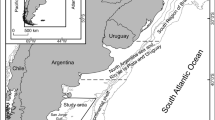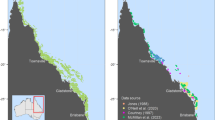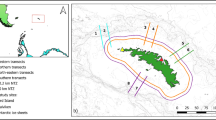Abstract
In recent years, the small pelagic fishery on the Pacific northwest coast of Mexico has significantly increased fishing pressure on thread herring Opisthonema spp. This fishery is regulated using a precautionary approach (acceptable biological catch (ABC) and minimum catch size). However, due to fishing dynamics, fish aggregation habits and increased fishing mortality, periodic biomass assessments are necessary to estimate ABC and assess the resource status. The Catch-MSY approach was used to analyze historical series of thread herring catches off the western Baja California Sur (BCS, 1981–2018) and the Gulf of California (GC, 1972–2018) to estimate exploitable biomass and target reference points in order to obtain catch quotas. According to the results, in GC, the maximum biomass reached in 1972 (at the beginning of fishery) and minimum biomass reached in 2015; the estimated exploitable biomass for 2019 was 42.2×104 t; and the maximum sustainable yield (MSY) was 15.4×104 t. In the western BCS coast, the maximum biomass was reached in 1981 (at the beginning of fishery) and minimum biomass was reached in 2017; the estimated exploitable biomass for 2019 was 3.2×104 t; and the MSY was 1.2×104 t. Both stocks showed a decrease in biomass over the past years and were currently near to point of full exploitation. The results suggest that the use of the Catch-MSY method is suitable to obtain annual biomass estimates, in order to establish an ABC, to know the current state of the resource, and to avoid overcoming the potential recovery of the stocks.
Similar content being viewed by others
References
Barange M, Bernal M, Cergole M C, et al. 2009. Current trends in the assessment and management of stocks. In: Checkley D, Alheit J, Oozeki Y, et al., eds. Climate Change and Small Pelagic Fish. Cambridge: Cambridge University Press, 191–255
Berry F H, Barrett I. 1963. Gillraker analysis and speciation in the thread herring genus Opisthonema. Inter-American Tropical Tuna Commission Bulletin, 7(2): 110–190
Castro-González J J, Galindo-Cortes G, De la Cruz F J, et al. 2013. Dictamen técnico para la recomendación de la cuota de captura de Curvina golfina (Cynoscion othonopterus) en el Alto Golfo de California, Temporada de pesca 2013–2014. Ensenada, Mexico: Instituto Nacional de la Pesca, Secretaría de Agricultura y Desarrollo Rural of México, 8
Cervigón F, Bastida R. 1974. Contribución al conocimiento de la fauna ictiológica de la provincia de Buenos Aires. Anales de la Sociedad Científica Argentina, 197: 3–20
Cisneros-Mata M A, Nevárez-Martínez M O, Hammann M G. 1995. The rise and fall of the Pacific sardine, Sardinops sagax caeruleus Girard, in the Gulf of California, Mexico. California Cooperative Oceanic Fisheries Investigations Reports, 36: 136–143
Comisión Nacional de Acuicultura y Pesca. 2011. Anuario Estadístico de Acuacultura y Pesca. Mazatlán, México: Comisión Nacional de Acuicultura y Pesca, Secretaría de Agricultura y Desarrollo Rural, 311
Costello C, Gaines S D, Lynham J. 2008. Can catch shares prevent fisheries collapse?. Science, 321(5896): 1678–1681, doi: https://doi.org/10.1126/science.1159478
Diario Oficial de la Federación. 2012. Plan de Manejo Pesquero para la Pesquería de Pelágicos Menores (Sardinas, Anchovetas, Macarela y Afines) del noroeste de Mexico. Ciudad de Mexico, México: Diario Oficial de la Federación, 51
Diario Oficial de la Federación. 2019. Norma Oficial Mexicana NOM-003-SAG/PESC-2018 Para regular el aprovechamiento de las especies de peces pelágicos menores con embarcaciones de cerco, en aguas de jurisdicción federal del océano pacífico, incluyendo el Golfo de california. Ciudad de México, México: Diario Oficial de la Federación, 15
Enciso C E. 2014. Evaluación de la pesquería de curvina golfina Cynoscion othonopterus (Gilbert y Jordan, 1882) en el Alto Golfo de California [dissertation]. Mazatlán, México: Facultad de Ciencias del Mar, Universidad Autónoma de Sinaloa, 65
Fréon P, Cury P, Shannon L, et al. 2005. Sustainable exploitation of small pelagic fish stocks challenged by environmental and ecosystem changes: a review. Bulletin of Marine Science, 76(2): 385–462
Froese R, Pauly D. 2019. World Wide Web electronic publication. FishBase. https://www.fishbase.in/search.php [2020-12-21]
García-Borbón F. 2009. Construcción de un modelo estructurado por edades para la determinación del inicio de temporada de captura de camarón café (Farfantepenaeus californiesis, Holmes) en Bahía Magdalena-Almejas, Baja California Sur, México [dissertation]. La Paz, Mexico: Centro Interdisciplinario de Ciencias Marinas, 194
Haddon M J. 2011. Modelling and Quantitative Methods in Fisheries. 2nd ed. Boca Raton, Florida: Chapman and Hall/CRC Press, 449
Hilborn R, Walters C J. 1992. Quantitative fisheries stock assessment: choice, dynamics and uncertainty. Reviews in Fish Biology and Fisheries, 2(2): 177–178, doi: https://doi.org/10.1007/BF00042883
Hsieh C H, Kim H J, Watson W, et al. 2009. Climate-driven changes in abundance and distribution of larvae of oceanic fishes in the southern California region. Global Change Biology, 15(9): 2137–2152, doi: https://doi.org/10.1111/j.1365-2486.2009.01875.x
Jacob-Cervantes M L. 2010. La pesquería de peces pelágicos menores en el sur del Golfo de California. Análisis de la temporada de pesca 2008. Ciencia Pesquera, 18(2): 47–58
Ji Yupeng, Liu Qun, Liao Baochao, et al. 2019. Estimating biological reference points for Largehead hairtail (Trichiurus lepturus) fishery in the Yellow Sea and Bohai Sea. Acta Oceanologica Sinica, 38(10): 20–26, doi: https://doi.org/10.1007/s13131-019-1343-4
Kimura D K, Tagart J V. 1982. Stock reduction analysis, another solution to the catch equations. Canadian Journal of Fisheries and Aquatic Sciences, 39(11): 1467–1472, doi: https://doi.org/10.1139/f82-198
Lanz E, Nevárez-Martínez M, López-Martínez J, et al. 2009. Small pelagic fish catches in the Gulf of California associated with sea surface temperature and chlorophyll. California Cooperative Oceanic Fisheries Investigations Reports, 50: 134–146
Li Jiuqi, Ye Changchen, Wang Wenbo, et al. 2011. A stock assessment of small yellow croaker by Bayes-based Pella-Tomlinson model in the East China Sea. Journal of Shanghai Ocean University (in Chinese), 20(6): 873–882
Lin Longshan. 2009. Study on the fishery biology and management strategy of Larimichthys polyactis in the southern Yellow Sea and the East China Sea (in Chinese) [dissertation]. Qingdao: Ocean University of China
Lluch-Belda D, Magallon F J, Schwartzlose R A. 1986. Large fluctuations in the sardine fishery in the Gulf of California: possible causes. California Cooperative Oceanic Fisheries Investigations Reports, 27: 136–140
MacCall A D. 1975. Density dependence of catchability coefficient in the California Pacific sardine, Sardinops sagax caerulea, purse seine fishery. California Cooperative Oceanic Fisheries Investigations Reports, 18: 136–148
Martell S, Froese R. 2013. A simple method for estimating MSY from catch and resilience. Fish and Fisheries, 14(4): 504–514, doi:https://doi.org/10.1111/j.1467-2979.2012.00485.x
Nevárez-Martínez M O, Martínez-Zavala M A, Jacob-Cervantes M L, et al. 2014. Peces Pelágicos Menores Sardinops sagax, Opisthonema spp., Scomber japonicus, Engraulis mordax, Cetengraulis mysticetus, Etrumeus teres, Trachurus symmetricus, Oligoplites spp. In: Beléndez-Moreno L F J, Espino-Barr E, Galindo-Cortes G, et al., eds. Sustentabilidad y Pesca Responsable en México: Evaluación y Manejo 2013. Secretaria de Agricultura, Ganadería, Desarrollo Rural, Pesca y Alimentación, México: Instituto Nacional de la Pesca, 453
Pérez-Quiñonez C, Quiñonez-Velázquez C, García-Rodríguez F J. 2018. Detecting Opisthonema libertate (Günther, 1867) phenotypic stocks in northwestern coast of México using geometric morphometrics based on body and otolith shape. Latin American Journal of Aquatic Research, 46(4): 779–790, doi: https://doi.org/10.3856/vol46-issue4-fulltext-15
Perrotta R G, Viñas M D, Hernandez D R, et al. 2001. Temperature conditions in the Argentine chub mackerel (Scomber japonicus) fishing ground: implications for fishery management. Fisheries Oceanography, 10(3): 275–283, doi: https://doi.org/10.1046/j.1365-2419.2001.00171.x
Polacheck T, Hilborn R, Punt A E. 1993. Fitting surplus production models: comparing methods and measuring uncertainty. Canadian Journal of Fisheries and Aquatic Sciences, 50(12): 2597–2607, doi: https://doi.org/10.1139/f93-284
Post J R, Sullivan M, Cox S, et al. 2002. Canada’s recreational fisheries: the invisible collapse?. Fisheries, 27(1): 6–17, doi: https://doi.org/10.1577/1548-8446(2002)027<0006:CRF>2.0.CO;2
Prager M H. 1994. A suite of extensions to a nonequilibrium surplus production model. Fishery Bulletin, 92: 347–389
Radovich J. 1976. Catch-per-unit-of-effort: fact, fiction, or dogma. California Cooperative Oceanic Fisheries Investigations Reports, 18: 31–33
Ricard D, Minto C, Jensen O P, et al. 2012. Examining the knowledge base and status of commercially exploited marine species with the RAM legacy stock assessment database. Fish and Fisheries, 13(4): 380–398, doi: https://doi.org/10.1111/j.1467-2979.2011.00435.x
Ricker W E. 1975. Computation and Interpretation of Biological Statistics of Fish Populations. Ottawa, Canada: Department of Fisheries and Oceans
Rodríguez-Domínguez G, Castillo-Vargasmachuca S G, Pérez-González R, et al. 2014. Catch—Maximum sustainable yield method applied to the crab fishery (Callinectes spp.) in the Gulf of California. Journal of Shellfish Research, 33(1): 45–51, doi:https://doi.org/10.2983/035.033.0106
Ruelas-Peña J H, Valdez-Muñoz C, Aragón-Noriega E A. 2013. La pesquería de la corvina golfina y las acciones de manejo en el Alto Golfo de California, México. Latin American Journal of Aquatic Research, 41(3): 498–505
Ruiz-Domínguez M, Quiñonez-Velázquez C. 2018. Age, growth, and mortality of Opisthonema libertate on the coasts of northwestern México. Ciencias Marinas, 44(4): 235–250, doi: https://doi.org/10.7773/cm.v44i4.2908
Ruiz-Luna A, Lyle F L P. 1992. Fluctuaciones periódicas de la captura de sardina crinuda (Opisthonema spp.) en el Golfo de California, 1972–1990. California Cooperative Oceanic Fisheries Investigations Reports, 33: 124–129
Schaefer M B. 1954. Some aspects of the dynamics of populations important to the management of commercial marine fisheries. Bulletin of the Inter-American Tropical Tuna Commission, 1(2): 23–57
Schaefer M B. 1957. A study of the dynamics of the fishery for yellowfin tuna in the Eastern Tropical Pacific Ocean. Bulletin of the Inter-American Tropical Tuna Commission, 2(6): 247–268
Sullivan K J. 1991. The estimation of parameters of the multispecies production model. ICES Marine Science Symposium, 193: 185–193
Thompson W F, Bell F H. 1934. Biological statistics of the Pacific halibut fishery. (2) Effect of changes in intensity upon total yield and yield per unit of gear. Washington: Reports of the International Pacific Halibut Commission, 1–49
Vega Corrales L A. 2010. Population evaluation of the explotable stock of the Opisthonema complex (Pisces: Clupeidae) in the Gulf of Nicoya, Costa Rica. Journal of Marine and Coastal Sciences, 2: 83–94
Vera M D J Z, Vera M N Z. 2016. Consideraciones generales acerca del Opisthonema spp. (pinchagua). Ecuador. Dominio de las Ciencias, 2: 53–62
Wang Yu, Liu Qun. 2013. Application of CEDA and ASPIC computer packages to the hairtail (Trichiurus japonicus) fishery in the East China Sea. Chinese Journal of Oceanology and Limnology, 31(1): 92–96, doi: https://doi.org/10.1007/s00343-013-2073-7
Whitehead P J P, Rodríguez-Sánchez R. 1995. Clupeidae: Sardinas, Sardinetas, Machuelos, Sabalos, Piquitinga. In: Fischer W, Krupp F, Schneider W, et al., eds. Guía FAO Para Identificación de Especies Para los Fines de la Pesca. Pacífico Centro-Oriental. Volumen II, Peces Oseos Parte 1. Rome: FAO, 1015–1025
Xu Kaida, Liu Zifan. 2007. The current stock of large yellow croaker Pseudosciaena crocea in the East China sea with respects of its stock decline. Journal of Dalian Fisheries University (in Chinese), 22(5): 392–396
Xu Hanxiang, Liu Zifan, Zhou Yongdong, et al. 2011. The relation between parents and recruitment of hairtail on status of summer closed fishing in East China Sea. Fishery Modernization (in Chinese), 38(1): 64–69
Zhang Kui, Chen Zuozhi. 2015. Using Bayesian state-space modelling to assess Trichiurus japonicus stock in the East China Sea. Journal of Fishery Sciences of China (in Chinese), 22(5): 1015–1026
Zhang Kui, Zhang Jun, Xu Youwei, et al. 2018. Application of a catch-based method for stock assessment of three important fisheries in the East China Sea. Acta Oceanologica Sinica, 37(2): 102–109, doi: https://doi.org/10.1007/s13131-018-1173-9
Zhu Lixin, Li Lifang, Liang Zhenlin. 2009. Comparison of six statistical approaches in the selection of appropriate fish growth models. Chinese Journal of Oceanology and Limnology, 27(3): 457–467, doi: https://doi.org/10.1007/s00343-009-9236-6
Zwolinski J P, Demer D A. 2012. A cold oceanographic regime with high exploitation rates in the Northeast Pacific forecasts a collapse of the sardine stock. Proceedings of the National Academy of Sciences of the United States of America, 109(11): 4175–4180, doi: https://doi.org/10.1073/pnas.1113806109
Acknowledgements
We thank the Instituto Nacional de Pesca y Acuacultura through its program on small pelagic fish CRIAP Guaymas for information provided. The manuscript was greatly benefited by the comments and suggestions of two anonymous reviewers.
Author information
Authors and Affiliations
Corresponding author
Additional information
Foundation item
The Fund of Secretaría Académica y de Investigación of the Instituto Politécnico Nacional; the Fund of the National Council for Science and Technology (Mexico) and Instituto Politécnico Nacional; the Fund of the Comisión de Operación y Fomento de Actividades Académicas-Instituto Politécnico Nacional.
Rights and permissions
About this article
Cite this article
Ruiz-Domínguez, M., Quiñonez-Velázquez, C., Arizmendi-Rodriguez, D.I. et al. Assessment of the exploitable biomass of thread herring (Opisthonema spp.) in northwestern Mexico. Acta Oceanol. Sin. 40, 53–65 (2021). https://doi.org/10.1007/s13131-021-1785-3
Received:
Accepted:
Published:
Issue Date:
DOI: https://doi.org/10.1007/s13131-021-1785-3




